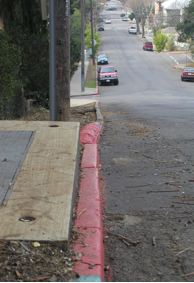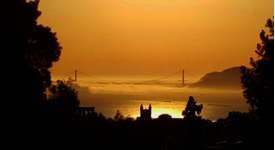7
For the first time during this tour you are not standing on either the west side of the Hayward Fault or directly on it, but on its east side. Can you pinpoint the spot where you crossed the fault? While looking for the crossing point keep in mind that the fault shows an appreciable level of aseismic creep in this area. Because the mechanics of the Hayward Fault is right lateral, and you are looking across the fault, the creep should have moved items on the other side of the fault to your right. Well, if you guessed you crossed the fault where the curbs of Dwight Way are offset, then you are correct. Sometimes parked cars make these offsets difficult to see. The best viewing point is looking downhill to the west from the south side of Dwight Way. The crooked curb near the power pole is exactly where the active trace of the fault crosses the street (see figure 5.18).

On a clear day, when the Bay is not shrouded in fog you might spot from this view point another feature important to our local geotectonics. Far beyond the Golden Gate Bridge you may see the Farallon Islands, several dozen rocks of solid granite which rise up to 360 ft above sea level. Because granite is not a very common rock anywhere in the Bay Area, how did it get to this spot about 30 miles offshore from San Francisco? The granite of the Farallons is actually very similar to the granite of the southern extensions of the Sierra Nevada. The same forces, which tug on the stadium walls and make the curbs on the street in front of you bulge, were also instrumental in transporting the granite to its current location. The Farallon Islands are actually part of the Pacific Plate, which slides with a speed of about 2 inches per year in a northwesterly direction past the North American Plate. Together with the San Andreas Fault to the west of us and the Calaveras Fault further east, the Hayward Fault here at the foot of the East Bay Hills marks the active boundary zone between these two plates. Everything fault related you have seen on this tour is part of the bigger picture of Plate Tectonics, the eternal movement of the puzzle pieces of the outer shell of the Earth as they drift over the semi-molten Earth’s mantle deep below our feet.

